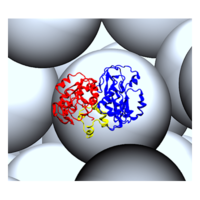Abstract
Inside the cell, proteins fold and perform complex functions through global structural rearrangements. For proper function, they need to be at the brink of instability to be susceptible to small environmental fluctuations yet stable enough to maintain structural integrity. These apparently conflicting properties are exhibited by systems near a critical point, where distinct phases merge. This concept goes beyond previous studies that propose proteins have a well-defined folded and unfolded phase boundary in the pressure-temperature plane. Here, by modeling the protein phosphoglycerate kinase (PGK) on the temperature (), pressure (), and crowding volume-fraction () phase diagram, we demonstrate a critical transition where phases merge, and PGK exhibits large structural fluctuations. Above the critical temperature (), the difference between the intermediate and unfolded phases disappears. When increases, the moves to a lower . With experiments mapping the space, we verify the calculations and reveal a critical point at 305 K and 170 MPa that moves to a lower as increases. Crowding shifts PGK closer to a critical line in its natural parameter space, where large conformational changes can occur without costly free-energy barriers. Specific structures are proposed for each phase based on the simulation.
- Received 11 June 2019
- Revised 21 September 2019
DOI:https://doi.org/10.1103/PhysRevX.9.041035
Published by the American Physical Society under the terms of the Creative Commons Attribution 4.0 International license. Further distribution of this work must maintain attribution to the author(s) and the published article’s title, journal citation, and DOI.
Published by the American Physical Society
Physics Subject Headings (PhySH)
Popular Summary
Many proteins fold into a well-packed structure in order to function, yet the folded phase must remain sufficiently flexible. It is unclear how proteins satisfy these contradictory constraints, especially in the crowded environment of a cell. We propose that these properties can coexist by tuning where the protein operates within its temperature-pressure-crowding phase diagram. Phase diagrams may contain “critical points” where the difference between any two phases disappears, such as when liquid and vapor water become indistinguishable. We show that a protein can also have such a critical point. The enzyme phosphoglycerate kinase, which is involved in producing the energy molecule of the cell, turns out to have a very crowding-sensitive critical point, above which the protein forms new structures.
To paint a complete picture of the critical point for this protein, we expand upon the conventional temperature-pressure folding phase diagram by varying the amount of crowding from surrounding macromolecules using computational simulations, a simple statistical mechanical model, and experiments. From simulations, we observe an intricate phase diagram, which contains a critical point that moves to a lower temperature as the crowding increases. We complement our simulation results by deriving an equation for the critical line in the entire phase diagram. To test our computational model, we observe folding transitions of phosphoglycerate kinase by fluorescence experiments, which validate the predicted critical point behavior.
Our findings suggest that being near a critical point can be advantageous for a protein’s biological function.



